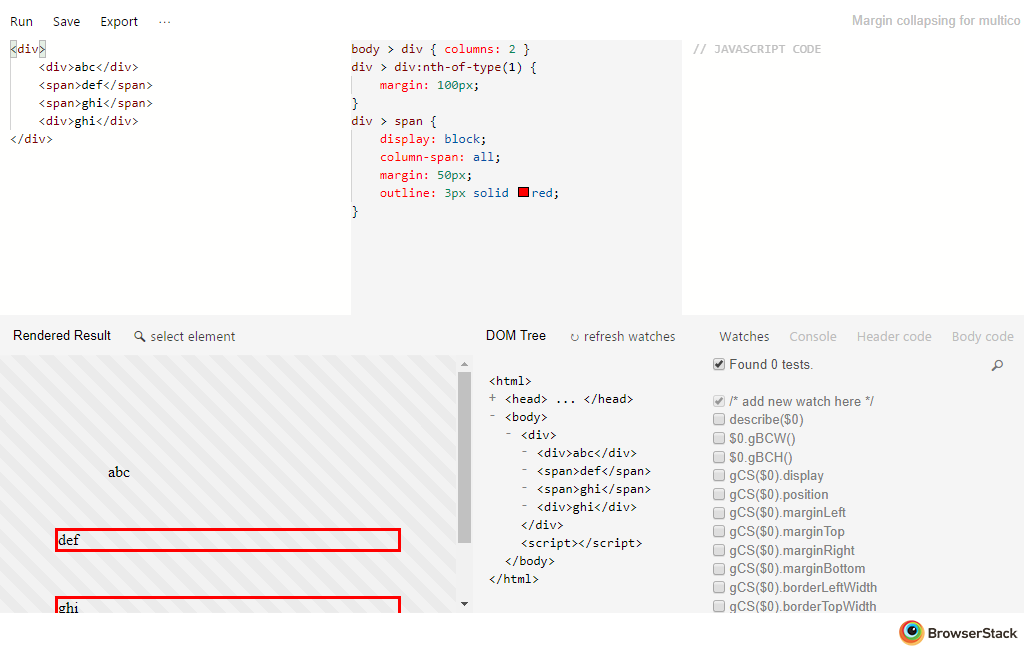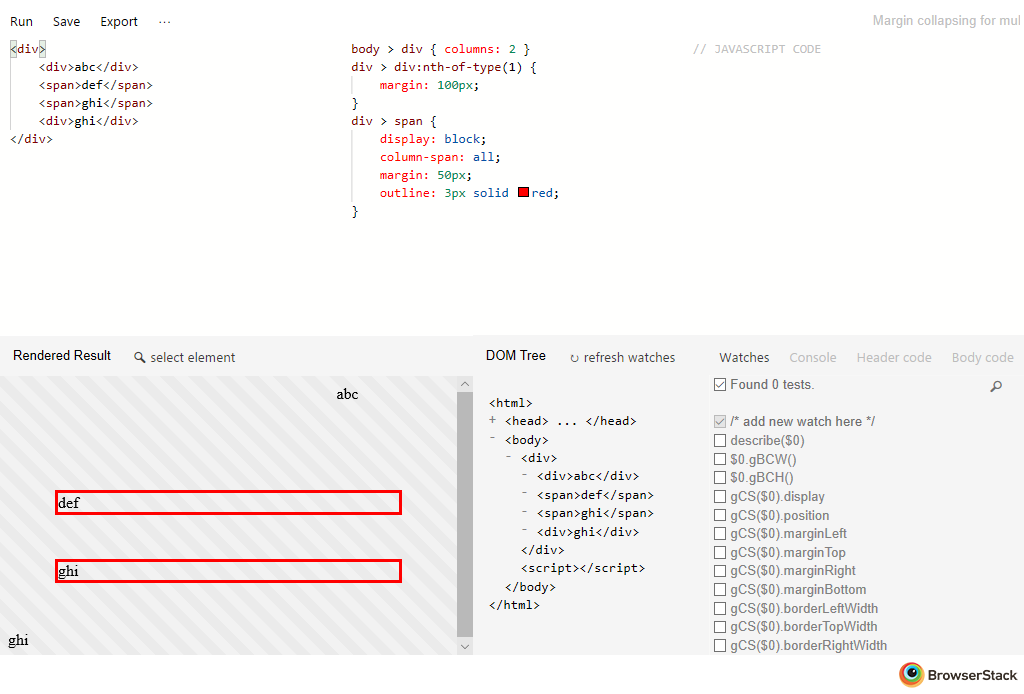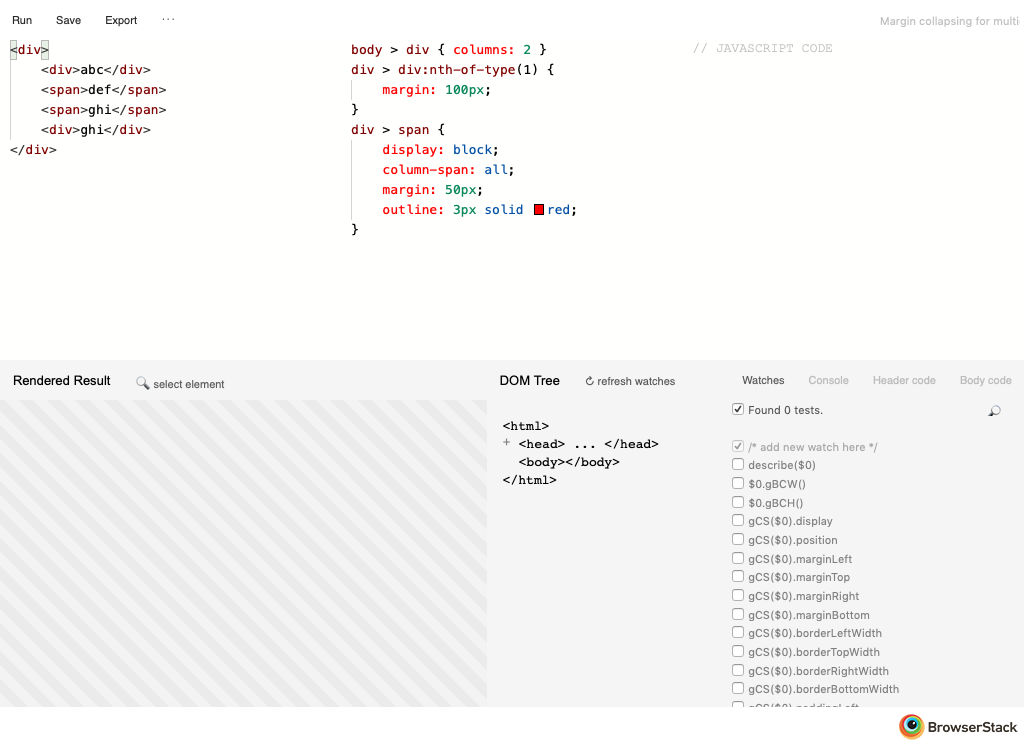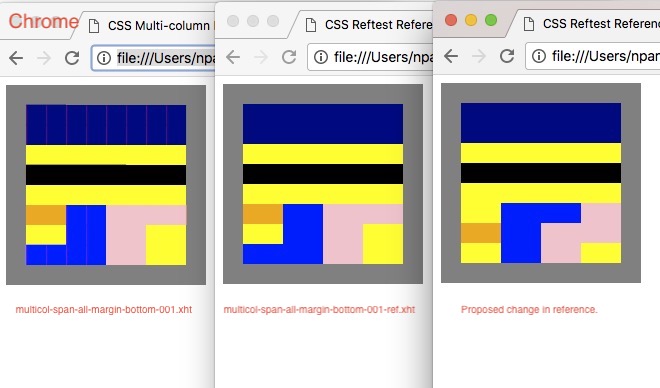New issue
Have a question about this project? Sign up for a free GitHub account to open an issue and contact its maintainers and the community.
By clicking “Sign up for GitHub”, you agree to our terms of service and privacy statement. We’ll occasionally send you account related emails.
Already on GitHub? Sign in to your account
[css-multicol] Margin collapsing does not make sense with column-spans. #2203
Comments
|
The other piece about the columns themselves not being BFCs (and only the multicol container establishing a BFC) is that technically, the way the spec is worded, a float in the second column has to have its top below the tops of all the floats in the first column (etc., for all the other float rules). But I think it's somewhat nonsensical for margins to collapse between something in a column and something that's column-spanning; it's also not clear where the resulting collapsed margin would end up. |
|
I am not entirely sure the proposed update makes sense. If you have an heading instead of an Orange box, you clearly would not want its top margin not to merge with the spanner bottom margin (this should be true for all columns, not just the first one). My understanding is that whatever margin is set on the spanner should get deduced of the margin required to be applied on the first element of each column. That seems to be the useful behavior here. |
|
The proposed change to the test reference mentioned in the first comment has been made in web-platform-tests/wpt#13395 |
|
@aethanyc Thanks for fixing that! @rachelandrew Thanks. I'm not going to the F2F, BTW. I still don't understand why columns (or fragmentainers in general) should establish a BFC, or what a BFC means for a fragmentainer. Fragmentainers don't capture floats, for instance, which BFCs are supposed to. I also don't understand what it solves to define them as BFCs. It would make slightly more sense if it were the column rows that establish BFCs, since they will be layout siblings of the spanners. But that would still not be quite right, since rows may be adjacent siblings (a multicol container laid out across several pages, for instance), and the float capturing gets confusing again. But I don't think I understand the problem with spanners and margin collapsing. Spanners vs. column rows in a multicol context is very similar to regular blocks vs. lines in non-fragmented layout. Of course, block margins on inline elements don't collapse with anything (they don't even grow the line). Spanners do not participate in the fragmentation context, like column content does. Would it help to introduce an anonymous wrapper in the spec, similar to what we have in CSS2 when blocks are siblings of inline boxes (then we wrap the inline boxes inside an anonymous block)? I.e. wrap column content inside a wrapper, which becomes a sibling of the spanners? The wrapper could establish a BFC and a fragmentation context and do multicol layout, while the spanners are on the outside (and the actual multicol container parent will just do regular block layout, consisting of spanners and anonymous multicol wrappers). Does this make sense? |
|
@mstensho thanks for the headsup re the f2f, if we can discuss this here then hopefully we can get this to a point where we have a proposed way forward. I'm not convinced I fully understand the issue with spanners, but it does keep coming up. The idea of an anonymous wrapper seems to make sense to me however. It would be interesting to hear from @dbaron and @neerjapancholi on that idea. |
|
@mstensho 's idea of the anonymous wrapper pretty much summarizes the ongoing implementation of |
|
That sounds good. Do you want me to elaborate on this proposal, or is it enough for the F2F (which I'm not attending)? |
|
@mstensho If you think there is anything you want to clarify that would be great, in order that I can be sure your views are represented in the discussion. |
|
(Sorry for the late response. I wrote something on Friday, but I noticed now that I must have failed to submit it somehow) The multi-column model(https://drafts.csswg.org/css-multicol/#the-multi-column-model) An element whose column-width or column-count property is not auto establishes a multi-column wrapper (needs a better name, I think). It's a regular block container, that establishes a new block formatting context. It consists of zero or more of the following types of children, in any order [*]:
[*] But there's no use-case for direct anonymous multi-column container siblings. Forbid? Spanners inside blocks(https://drafts.csswg.org/css-multicol/#column-span)
This is about situations like: Here #block contains regular column content, a spanner, and then some more regular column content. This means that #block occurs in two anonymous multi-column containers, one before and one after the spanner. This is similar to what happens in CSS 2 when we attempt to put a block-level child inside an inline - https://www.w3.org/TR/CSS22/visuren.html#anonymous-block-level :
In Multicolumnese, that would translate to something like:
Roughly: "s/inline box/block box/", "s/block-level box/column spanner/" and "s/line boxes/column rows/" Not sure if it'd make more sense to define a simpler model if there are no spanners. There's really no need for a separate wrapper and one anonymous multi-column child then, but defining one model for all situations is simpler, spec-wise, right? |
|
@mstensho This is exactly the mental model I had during the last set of multicol discussions we had this year. 100% in favor! |
|
The CSS Working Group just discussed
The full IRC log of that discussion<heycam> Topic: Margin collapsing does not make sense with column-spans<heycam> github: https://github.com//issues/2203 <heycam> dbaron: I think there are a few different things going on <heycam> ... I'm not sure which we've already solved <heycam> ... one is that one thing, at the time, nothing said that the columns inside a multicol create BFCs <heycam> ... the underlying question is can margins on column spans collapse <heycam> ... 2 questions under that <heycam> ... 1 is can the margin on a column span collapse with another column span right next to it <heycam> ... that one, we could maybe argue about <heycam> ... there are believable arguments on both sides <heycam> ... other question is can a margin on a column span collapse the first thing in the multi col part in the col span (??) <heycam> ... last time we looked at hte spec, it looked like it could collapse <heycam> florian: the spec is vague enough to read it that way <heycam> dbaron: the spec defines when margins can collapse, and nothing says they don't <fantasai> I like Morten's proposal in https://github.com//issues/2203#issuecomment-431695940 <heycam> ... I think I would strongly like to define that the margins of column spans don't collapse with margins of things in the columns <heycam> ... then there's the qn of can one column span's margin collapse with another <heycam> dbaron: there's a bunch of text in the issue I haven't looked at recently <heycam> fantasai: Morten posted a proposal, we don't have a strong definition of the multicol layout model in the spec <heycam> ... he proposes a model for exactly how the different formatting contexts interact <heycam> ... I think it makes a lot of sense. it gets us what dbaron said, but does that by defining the multicol container as being a BFC, and for it to contain column span and column containers, which are siblings, and they are laid out in a BFC, so the margins between spanners collapse <heycam> ... but the spanners define their own BFCs so they don't collapse with things in the columns <heycam> ... it's quite straightfrward and we should adopt it <heycam> florian: I believe we've previously resolved that does say hte margins between siblings spanners collapse, and that spanners and content in columns do not <heycam> ... at least in examples <heycam> Rossen: we could defer this to later on after people have had a chance to read it <heycam> florian: or I suggest we resolve on spanners collapsing with each other, but not content in the column <heycam> ... but not on the mechanism to achieve this <heycam> ... which we can do later <heycam> RESOLVED: margins between adjacent spanners do collapse <heycam> RESOLVED: margins between spanners and any other non-spanning boxes do not collapse |
|
I just wrote a testcase, and I don't understand what browsers are doing; this is wild... @rachelandrew @fantasai @frivoal |




I'm filing this based on a discussion I just had with @dbaron.
It seems like the multicol spec does not forbid margin collapsing with column-span elements. So the margin of a column-span can collapse w.r.t. just one column and that doesn't make sense. Also, the spec mentions that a multicol element itself creates a BFC but does not specifically say that the columns inside it also create a BFC. This might clarify the margin collapsing behavior for column-spans.
An example of an existing test where this can be seen is -
https://github.com/w3c/web-platform-tests/blob/master/css/css-multicol/multicol-span-all-margin-bottom-001.xht
Screenshots of Chrome - (Orange and black bands are the column-spans)

The text was updated successfully, but these errors were encountered: